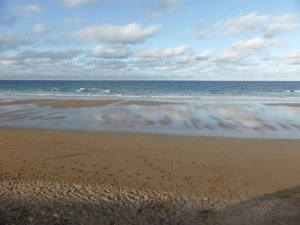I have tried to spend my time during my travels pursuing activities and seeing sights as unique to the countries visited as possible. Nowhere was this more the case than in visiting Tasmania, it had to be devils.
Tasmanian devils are synonymous with the Warner Brothers cartoon. I discovered that this was apparently based on, or at least inspired by, Errol Flynn. His father had been a zoologist working with the creatures. While the cartoon has little to do with any factual characteristics of devils, the personality of the cartoon character is said to have more than a passing resemblance to Errol himself.
Tasmanian Devils have been registered as an endangered species since 2004. To be found no where else in the world, Tasmanian Devils have seen their populations fluctuate in response to a variety of environmental changes. Most recently they have been struck by a facial cancer, with the rare ability to be passed from animal to animal. It is contracted when a devil is bitten by one which is infected. These are not uncommon injuries sustained for Tasmanian Devils, largely solitary animals they do come together when eating, and where there is competition they will fight over food. Generally scavengers they will, for example, eat road kill which can put them further in danger of being hit by vehicles themselves. A hotline was set up in recent years to monitor where devils were being found at the side of the road after being hit. This has determined sites for signposts, warning motorists and imposing lower speed limits to protect them.
Where my journey fits in is a successful application to Sydney University, to work as a volunteer on one of their research projects. Run in conjunction with the Australian and Tasmanian Governments, I joined a researcher on a field trip to monitor, collect data and microchip new devils captured. One of the four sites used, set in the rainforest of western Tasmania, the first thing I noticed was that it was cold. Spending so long in tropical temperatures I had been looking forward to a little relief from scorching heat, but this was on a par with the UK! I unpacked layers of thermals again and was grateful of my ill-fitting rather fetching overalls as another layer of clothing. Okay, so the temperature was still in double figures but I’ve been in thirty degree heat for the last five months. It was a bit of a shock. The next thing I noticed was the landscape, it is beautiful and very green, more akin to Scotland or England than you might associate with Australia. Staying in the coastal area of Stanley, the beaches ran on both sides of the town. It was idyllic.

Stanley coastline (Louise Kenward, 2014)
My first day and duties included helping to move furniture from storage, collecting a trailer, and looking for road kill. I probably hadn’t entirely thought this through. Of course, to monitor and collect data on devils you first need to catch them. To be able to catch them you need to bait traps, with things they eat, like road kill. I wasn’t entirely comfortable for the first few days, collected from the airport by this man in overalls with an axe and a large saw in the boot of the jeep, rolls of duct tape and bin bags, large plastic dustbins and so on, staying somewhere fairly remote without means of communication and spending our time on the look out for dead animals. I’m not sure, but this could have been the start to a film, one that did not end very happily for the person who got collected from the airport.
Nonetheless this was a Sydney University research project. I clung on to this information and reminded myself regularly.
Early starts, and once all the traps had been set, each day started with a drive around the site checking each of the thirty traps for sign of captures. Spotted tailed quolls, another marsupial unique to Tasmania, and also endangered, were occasionally found in the traps too. These needed to be processed and released as soon as they were found. They do not respond so well to being captured as the mild mannered Tasmanian Devil. Yes really, on the whole the devils we worked with were pretty placid, allowing us to poke and prod them, taking measurements and checking their teeth. The quolls however found the whole thing a good deal more stressful.
Once all the traps have been checked, those with devils needed to be returned to, animals processed and released before resetting the traps for the next day. Weight, measurements and general condition was recorded, along with injuries and parasites. Most of the population seen were juveniles, born last year, they were new to the project and needed microchipping and naming before releasing and paperwork being completed. Finding mostly juveniles also suggested that it may have been a site where the cancer has recently travelled through. It is an unusual site, however, seemingly a transient one so I look forward to learning of the future field trips results as to the status of the population. The numbers were up on the previous visit however, so I hope that this is a positive sign and that some of the measures put into place are of benefit. I’ve certainly enjoyed a first hand view and much better understanding for it of this little known creature. And, smelly or not, I do really like them.




